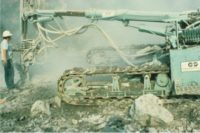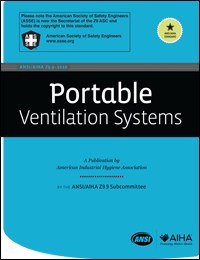Recommendations
1. In the Engineering and Work Practice Control Methods column, several operations state equipment should be operated “…such that no visible dust is emitted from the process”. AIHA is concerned that this is a subjective determination and can be influenced by several factors such as lighting, wind and direction, and angle of observation. Rounded corners, rough surfaces and other surface topography may make it impossible to keep a shroud or LEV inlet flush with the surface, thereby letting intermittent dust to escape. AIHA recommends this requirement be removed. Ensuring the proper use and functioning of the equipment is one of duties of the competent person, tool operator and employer. They can evaluate the overall situation on a case by case basis and determine if excessive dust is being released and if so take all required action.
2. As noted in the discussion section, silica exposure can be influenced by numerous variables. Several of the tasks in the less than 4 hour/day column do not require any supplemental respiratory protection. AIHA is concerned that these variables (and their inevitable, numerous and unpredictable combinations) may in some cases lead to exposures that are not adequately controlled. To account for some of this uncertainty, AIHA suggests OSHA require the employer to provide a minimum 1/2 face piece respirator, upon either employee request or competent person determination of need, for any Table 1 task that does not require a respirator. A filtering facepiece respirator supplied due to an employee request would be considered voluntary use under 29CFR1910.134. Use of an elastomeric respirator or a competent person determination would require full compliance with 29CFR1910.134.
3. In conjunction with recommendation #2, because engineering controls play such a critical role in worker exposure control, AIHA recommends OSHA require the employer to have a competent person whenever Table 1 is used for compliance purposes – regardless if respirator use is required or not.
It is our understanding based on Note 1 of Table 1, if a respirator is not required, the employer does not have to assume an overexposure to the PEL. That would mean a competent person is not required. The variability and potential magnitude of exposure during many of these tasks and the dependence solely on engineering controls indicates that a competent person should be available to ensure they are adequate for the specific situation. The use of Table 1 relieves the employer of having to do both initial and periodic air monitoring. Eliminating periodic air monitoring in turn removes one of the controls methods (as noted by OSHA in the discussion section of the NPRM) to ensure the engineering controls are functioning properly.
The AIHA White Paper Recommended Skills and Capabilities for Silica Competent Persons can be referenced as a non-regulatory guidance document on what a silica competent person should be able to do and when a qualified person needs to be called in for further situation evaluation.
4. AIHA recommends that for commercially available engineering controls (e.g. water spray, LEV) OSHA require that employers follow the manufactures’ user instructions for installation, use and maintenance of the equipment - unless there is written variance from the manufacturer.
5. AIHA recommends OSHA make the respirator requirements of Table 1 more performance oriented. Instead of specifying a particular respirator type - such as a half facepiece respirator - AIHA recommends specifying only that the respirator used meets or exceeds a specific APF as documented in 29CFR1910.134. AIHA is concerned that as Table 1 reads now, some employers may believe that the specified respirator is the type that must be used. Citing only a minimum APF makes it clear that any NIOSH approved respirator meeting or exceeding that APF may be used. This may in turn motivate employers to consider other respirator systems with higher APFs than the respirator type currently specified.
AIHA recommends OSHA clarify what time is included when determining less than or greater than 4 hours. Does time only include when dust is being actively generated (i.e. a saw is making a cut or a grinder is actually working on material)? AIHA recommends that time include overall run time of the tool i.e. actual dust generation time, positioning materials, measuring stock material in preparation for work, adjustment of tools.
69. Medical Surveillance.
Workers exposed to silica deserve medical surveillance to identify early signs of disease. Those who are exposed to higher levels (e.g. those doing silica generating tasks or working in regulated areas) are at greater risk and should be a high priority for medical surveillance, as well as those who have to wear respirators. Medical exams are not as necessary or useful for workers who have had less than 10-15 years of exposures, since the chances of finding any disease is minimal. OSHA may want to consider reducing the frequency for younger workers or reducing the frequency of tests like X-rays, as is done in the Asbestos standard.
The 30 day trigger for medical exams in the proposed rule is problematic for construction, where most workers are changing jobs and often changing employers every few weeks. Who will keep track of the number of days of exposure? How would it be verified? How would a compliance officer check? Would it lead to blacklisting workers who have had 29 days of exposure?
AIHA recommends that OSHA reconsider how medical exams are triggered in the standard to come up with a more useful trigger for a transient construction workforce.
78. Use of physicians and other licensed health care providers.
The industrial hygiene assessments and exposure monitoring are recognized to be "fairly challenging".
"Certification" is required for "B-readers (NIOSH-certified); American Board Certified Specialists (American Board of Medical Specialties (ABMS)) in Pulmonary Disease (“pulmonary specialists”); and physicians and other licensed health care providers (PLHCPs) performing medical examinations and procedures under the Standard (licensed, registered, or certified by state law).
Although the standard requires employers to conduct exposure monitoring to ensure dust controls are working properly, the standard is mute with respect to the qualification of those performing professional industrial hygiene tasks. Although the requirement for "industrial hygiene” and the use of "industrial hygienists" are written into the proposed Standard, the "certification" of the industrial hygienist is lacking. We strongly recommend that, as a minimum, the professional and technical oversight of the industrial hygiene aspects listed under the Standard be performed under the cognizance of a "Certified Industrial Hygienist (CIH)".
The inclusion of this nominal requirement ensures that the proper knowledge, skills, and abilities are held by the professionals performing this MOST IMPORTANT aspect of the proposed Standard.
Conclusion
AIHA appreciates the opportunity to work with OSHA to help achieve the mutual goal of protecting American workers from exposure to crystalline silica. As the agency moves forward, the AIHA offers its breadth of experience as a resource and we look forward to further opportunities to work with the agency on this and similar issues and regulatory priorities.
If AIHA can be of any further assistance, please contact me. Thank you.
Sincerely,
Barbara J. Dawson, CIH, CSP
AIHA President
AIHA submits comment on OSHA's proposed silica rule


